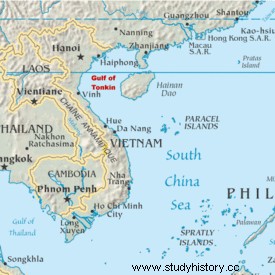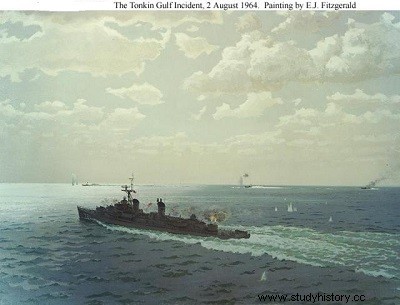
The Gulf of Tonkin Incidents occurred on August 2 and 4, 1964. North Vietnamese torpedo boats and two American destroyers, USS Maddox (DD-731) and USS C. Turner Joy, exchanged cannon fire.
The existence of the August 4 clash has long been controversial. Later evidence, including a 2005 report released by the National Security Agency, indicates that there was no North Vietnamese attack on August 4.
Incidents
On August 2, 1964, the American destroyer USS Maddox (DD-731), during a reconnaissance mission in the Gulf of Tonkin which began on July 31, declared that it had been attacked in international waters by three North Vietnamese torpedo boats. The Maddox, only hit by a machine gun bullet, retreated into South Vietnamese waters, where she was joined by the destroyer C. Turner Joy.
On August 4, the two American destroyers began a patrol towards the North Vietnamese coast. During the patrol, the C. Turner Joy receives sonar and radio signals which are interpreted as another attack by North Vietnamese torpedo boats. For nearly two hours, the American ships fired on targets detected by radar. It is highly unlikely that there were any North Vietnamese forces in this area during the fight. Captain John J. Herrick even admitted that it was nothing more than an "overzealous" sonar operator who "heard his own propeller beating." However, at this time, a large part of the crew really believed that they were under enemy fire. In 1995, General Võ Nguyên Giáp, then commander-in-chief of North Vietnamese forces, confirmed the August 2 attack but denied any involvement in the August 4 “incident”.
Throughout 1964, United States involvement in the Vietnam War increased. A covert program of South Vietnamese operations, designed to impose "gradually intensified pressure" on the North, began on a small scale in February. The active role of the Americans in the few secret operations carried out was essentially limited to planning, equipping and training the South Vietnamese forces involved. The facts were therefore at odds with the statement of Secretary of Defense Robert McNamara, who said on August 6, 1964:"Our Navy has played no role, has not been associated with, and is unaware of South Vietnamese, if any. ". Four years later, McNamara admitted to Congress that American ships had in fact cooperated with South Vietnamese attacks on the North.
On November 30, 2005, the National Security Agency released hundreds of pages of secret documents from the 1964 Gulf of Tonkin Incident.
Although information obtained well after the evening of August 4 indicated that there had been no actual North Vietnamese attack, American authorities and the entire crew claimed at the time that an attack had occurred. Therefore, fighters from the aircraft carriers Ticonderoga and Constellation were sent to strike torpedo boat bases and fuel installations.
In 1995, retired General Nguyen Giap, in an interview with ex-secretary of defense Robert Mcnamara, categorically denies that gunboats attacked American destroyers on August 4, 1964. A taped conversation of a meeting a few weeks after the Gulf of Tonkin resolution, published in 2001, reveals that Robert McNamara expressed doubts to President Johnson about the irrefutable likelihood of the attacks.
It is also established today that the Incidents in the Gulf of Tonkin were used to allow an escalation of the intervention of the United States in the Indochinese conflict. The Pentagon Papers revealed that the text of the Resolution was drafted by the Johnson administration several months before said "incidents" took place.

Works of Robert J. Hanyok
The most important document on the reality of the North Vietnamese attacks is a 2001 article in which a National Security Agency historian, Robert J. Hanyok, argues that agency intelligence officers deliberately misrepresented the facts. reports released to politicians and the public, to make it appear that North Vietnamese ships attacked American destroyers on August 4, 19642. Hanyok claims that 90 percent of North Vietnamese communications interceptions relate to the alleged attack of August 4, 1964, were omitted from major agency documents.
Robert J. Hanyok concludes that the NSA deliberately falsified intelligence reports regarding the August 4 incident. He concludes that the motivation was not political, but that it was a question of covering up intelligence errors committed without bad faith:the NSA indeed misinterpreted the North Vietnamese communications, concluding with an attack, then realizing her mistake, she concealed it from politicians.
Hanyok's findings were originally published inside the NSA in the Winter 2000/Spring 2001 edition of Cryptologic Quarterly. The New York Times revealed the case to the public in October 2005. According to intelligence officials, government historians wanted the report made public, but this was refused by the politicians concerned for fear that comparisons could be made. with the information used to justify the war in Iraq in 2003 [ref. needed].
Reviewing NSA records, Hanyok concludes that the NSA initially misinterpreted the North Vietnamese intercepts so that they appeared hostile on August 4. NSA officials discovered the mistake almost immediately, he said, but covered it up by altering the documents to make it appear that the second attack occurred. Robert McNamara, who was secretary of defense at the time of the incident, said in October 2005 that he believes intelligence reports regarding the Gulf of Tonkin incident were instrumental in the expansion of the war. P>
Strengths
1 aircraft carrier
1 destroyer
4 aircraft
3 gunboats
Losses
1 destroyer slightly damaged
1 aircraft slightly damaged 1 torpedo boat severely damaged
2 torpedo boats moderately damaged
4 killed
Ancient history
